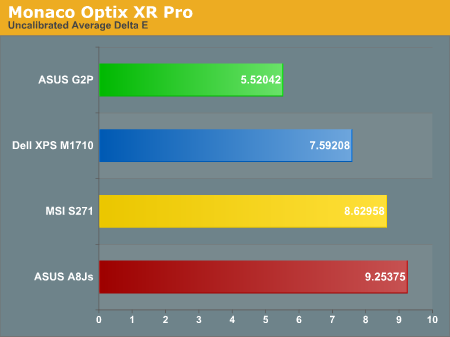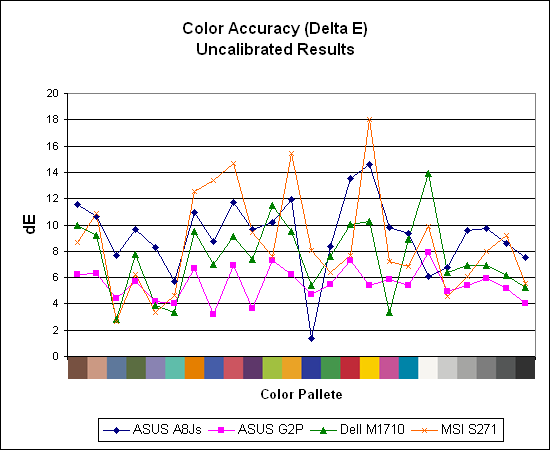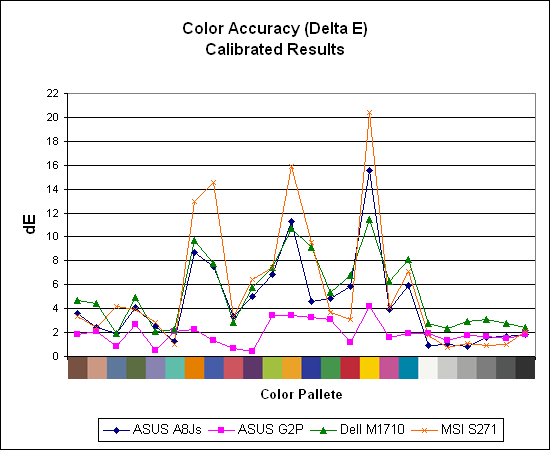Laptop LCD Roundup: Road Warriors Deserve Better
by Jarred Walton on May 22, 2007 5:00 AM EST- Posted in
- Displays
Color Accuracy
Other than adjusting the brightness level, there's not much that can be done with a laptop to change the default color values. The vast majority of users almost certainly use no color profile, so our uncalibrated color accuracy charts will be the most meaningful for them. Some people require more accurate colors, however, and while our instinct says that none of these displays can match the quality of the desktop LCD - even the best of them seems noticeably inferior to any of the desktop LCDs we've reviewed - the only way to prove or disprove this opinion is through actual objective testing.
During testing, Monaco Optix XR Pro sends 24 color patches to the display with the colorimeter measuring the resulting values. The difference between what is requested and what the LCD actually shows is known as Delta E, with lower values being better. Any score less than one is basically "perfect" - the naked eye is not going to be able to tell the difference - and scores less than 2.0 are very nearly perfect. Ideally, for accurate colors you would want all of the tested colors to have a Delta E of less than 1.0, but almost no one is likely to have problems with anything scoring below 2.0. From 2.0 to 4.0, most people still won't notice the slight inaccuracies in the color palette, but when comparing displays side by side differences may be apparent; multimedia professionals would prefer something better. Anything above 4.0 begins to represent a more significant deviance, and numerous scores above 6.0 will almost certainly be noticeable by just about anyone. Beware also of spikes in the Delta E charts, as a low average Delta E with several high spikes may not be as good in actual use as a display that offers a higher average Delta E but without the spikes.
Uncalibrated Results


Without any form of color correction, the color accuracy of all of these displays is poor. The ASUS G2P clearly generates the best overall score with a Delta E result of 5.52. However, there are still plenty of colors that fall above the 6.0 threshold, and even one that hits 8.0. As bad as that might seem, the other three displays are clearly worse. The XPS M1710 places second by a reasonable margin, but with several colors showing a Delta E of over 10.0 it's certainly nothing special. The MSI and ASUS A8Js both exhibit extremely poor color accuracy, with multiple large spikes on certain colors. We've seen some relatively poor uncalibrated results on desktop displays that have been turned around after calibration, so let's see if that's the case here.
Calibrated Results


If you were hoping for a turnaround after calibration, the above charts are probably pretty disappointing. As we've mentioned several times already, the ASUS G2P is far and away the best LCD out of the laptops we've used, and the calibrated color results bear this fact out. By no means are the results perfect, but with an average Delta E of 1.95 it at least comes relatively close, and only one color actually falls above the 4.0 threshold.
The other three laptops all get lower average Delta E scores after calibration, but they all have very similar curves with certain colors that simply cannot be accurately displayed. Yellows and blues in particular seem to present problems for many laptops, and there are a few colors that actually got worse after calibration! The backlighting used on a display can have a very large impact on the color accuracy, and we would venture to guess that most laptops are using similar low-power lamps that don't cover a lot of the standard NTSC color gamut. For anyone that's serious about doing image editing work on a laptop, consider this a warning that you will want to get a separate desktop LCD if possible in order to get a better representation of colors.
Other than adjusting the brightness level, there's not much that can be done with a laptop to change the default color values. The vast majority of users almost certainly use no color profile, so our uncalibrated color accuracy charts will be the most meaningful for them. Some people require more accurate colors, however, and while our instinct says that none of these displays can match the quality of the desktop LCD - even the best of them seems noticeably inferior to any of the desktop LCDs we've reviewed - the only way to prove or disprove this opinion is through actual objective testing.
During testing, Monaco Optix XR Pro sends 24 color patches to the display with the colorimeter measuring the resulting values. The difference between what is requested and what the LCD actually shows is known as Delta E, with lower values being better. Any score less than one is basically "perfect" - the naked eye is not going to be able to tell the difference - and scores less than 2.0 are very nearly perfect. Ideally, for accurate colors you would want all of the tested colors to have a Delta E of less than 1.0, but almost no one is likely to have problems with anything scoring below 2.0. From 2.0 to 4.0, most people still won't notice the slight inaccuracies in the color palette, but when comparing displays side by side differences may be apparent; multimedia professionals would prefer something better. Anything above 4.0 begins to represent a more significant deviance, and numerous scores above 6.0 will almost certainly be noticeable by just about anyone. Beware also of spikes in the Delta E charts, as a low average Delta E with several high spikes may not be as good in actual use as a display that offers a higher average Delta E but without the spikes.
Uncalibrated Results


Without any form of color correction, the color accuracy of all of these displays is poor. The ASUS G2P clearly generates the best overall score with a Delta E result of 5.52. However, there are still plenty of colors that fall above the 6.0 threshold, and even one that hits 8.0. As bad as that might seem, the other three displays are clearly worse. The XPS M1710 places second by a reasonable margin, but with several colors showing a Delta E of over 10.0 it's certainly nothing special. The MSI and ASUS A8Js both exhibit extremely poor color accuracy, with multiple large spikes on certain colors. We've seen some relatively poor uncalibrated results on desktop displays that have been turned around after calibration, so let's see if that's the case here.
Calibrated Results


If you were hoping for a turnaround after calibration, the above charts are probably pretty disappointing. As we've mentioned several times already, the ASUS G2P is far and away the best LCD out of the laptops we've used, and the calibrated color results bear this fact out. By no means are the results perfect, but with an average Delta E of 1.95 it at least comes relatively close, and only one color actually falls above the 4.0 threshold.
The other three laptops all get lower average Delta E scores after calibration, but they all have very similar curves with certain colors that simply cannot be accurately displayed. Yellows and blues in particular seem to present problems for many laptops, and there are a few colors that actually got worse after calibration! The backlighting used on a display can have a very large impact on the color accuracy, and we would venture to guess that most laptops are using similar low-power lamps that don't cover a lot of the standard NTSC color gamut. For anyone that's serious about doing image editing work on a laptop, consider this a warning that you will want to get a separate desktop LCD if possible in order to get a better representation of colors.










55 Comments
View All Comments
Axbattler - Tuesday, May 22, 2007 - link
I am also very interested in this. I know that the Sony screen tend to be a love or hate affair: on one hand they are bright and and clear, but many can't get past the reflection. I'd like to know if there are any monitors that's similar to Sony's minus the refection.figuerc - Tuesday, May 22, 2007 - link
My Thinkpad X60 tablet still comes with an IPS screen and it is the best screen I have ever used period.Pirks - Tuesday, May 22, 2007 - link
yeah, this article is a waste of time considering they have omitted IPS screen notebooks. I saw the title, thought "yess!!" and went to read it, you know I always wanted to see good comparison between IPS and TN notebook displays... and in the first page they write "uh we don't know about any notebook with IPS panel" - WTF?! alright Anand and Co, it was agood job, you barely made it but to make TRYLY high-quality article you really have to include at least one IPS thinkpad. I'll keep waiting for your _proper_ notebook screen comparison article, it's likely you do it firstafter all I haven't seen decent notebook TN panel reviews online before yours, so once you add an IPS notebook - job's done!
DigitalFreak - Tuesday, May 22, 2007 - link
Again Pirks, STFU.Pirks - Tuesday, May 22, 2007 - link
sorry for typos, I pressed post button too quick, should be truly not trylyJarredWalton - Tuesday, May 22, 2007 - link
This is a starting point Pirks, not an end point. I tried to make that clear. All notebooks that we review in the future will include a more in-depth review of the display. As for getting the Lenovo Thinkpad X60 (or something similar if there are other IPS laptops), we're working on it. Unfortunately, previous attempts to contact Lenovo for a review unit have been unsuccessful, so we review what we have.Pirks - Wednesday, May 23, 2007 - link
okay, okay, if this is just the beginning - I'm going to STFU, if only to make DigitalFreak quietwaiting for your IPS notebook reviews, and thanks for making this just the beginning - I really like the idea of the article, and IPS panels is the only things that's missing
I wasn't criticizing the article per se, I only disliked the omission of the IPS panels. sorry for not stating it clearly
JarredWalton - Wednesday, May 23, 2007 - link
I knew what you meant, and I was glad to find out that I was wrong and that there were some non-TN panels available in laptops. I'll be curious to see if the IPS models (assuming I can get some sent my way) perform noticeably better. After all, the best of the laptops I've looked at so far still trails behind desktop TN models, most likely due to backlighting and power concerns. It could be that the IPS laptops follow that trend.Pirks - Wednesday, May 23, 2007 - link
hey Jarred, here's another mistake you made in the article: "LED backlighting is one technology that holds a lot of promise, and it has only just begun to show up on desktop LCDs" - now don't you know that Sony has been selling notebooks with LED backlighting for some time already? why have you said that it only appeared on desktop LCD while in fact Sony was making notebooks with LEDs waaay before desktop LCDs with LED appeared?Pirks - Wednesday, May 23, 2007 - link
exactly! this is why I'm waiting for your IPS panel notebooks article veeery impatiently! bring it on! :)